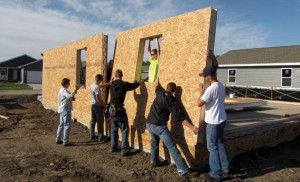Construction management majors build 50th Brookings Habitat house

Construction management majors in the College of Engineering teamed with Brookings Area Habitat for Humanity in building the 50th Habitat for Humanity home. Here they put up a wall on the house located at 1141 Pactola Cove in Brookings. It marks the sixth consecutive year that the construction management program has worked with Habitat personnel to build a house in the Brookings area.
Patrick DeBoer will always remember 1141 Pactola Cove. He can point to the address knowing that he was part of a team of students who made a difference for a Brookings family.
“This is a great way for us to get out and get involved,†says the Clear Lake senior. “Obviously it’s a class for us, but yet we’re gaining experience from it and we’re also helping the community. I think it’s a good thing all the way around.â€
DeBoer was the student site supervisor of 12 construction management majors in the College of Engineering that teamed with Brookings Area Habitat for Humanity in building the 50th Habitat for Humanity home.
It marks the sixth consecutive year that the construction management program has worked with Habitat personnel to build a house in the Brookings area.
Twelve students in the construction technical elective class participated in the construction. Work on the home commenced Sept. 7 and it was dedicated Oct. 28.
The students not only gained good experience in the construction process, but they also earned college credit. They were required to commit to 30 hours per credit. For those seeking three credits they had to put in 90 hours on the job site.
Completed in short fashion
Norma Nusz-Chandler, instructor in the construction management program and coordinator of the elective class, was impressed with the students’ work, considering the relatively short time it took to build the house.
“I’m proud of the students who step up and make the commitment to follow through with it,†she says. “It’s a heavy workload for them to come and do the house in such a short time frame.
“It’s rewarding to see because I like to think that we are all here for a purpose and that purpose is to improve the quality of life for people. By participating in this project they really have made an impact on this family.â€

Work on the home commenced Sept. 7 and it was dedicated Oct. 28. The students not only gained good experience in the construction process, but they also earned college credit. They were required to commit to 30 hours per credit. For those seeking three credits they had to put in 90 hours on the job site.
The local Habitat for Humanity chapter was formed in 1995 by people interested in bettering the lives of families in the Brookings area.
Habitat’s regular volunteers did the site prep work and capped the foundation to get it all prepared for the construction management students to begin their work. Habitat then followed up with a few construction details to help the students finish in time to showcase the home.
“Back when we first started I didn’t think we’d be building 50,†says David Clark, a Habitat construction assistant. “It’s great to partner with SDSU and having the students come out here.
“You couldn’t ask for a better way to get some good hands-on experience and be involved with Habitat at the same time. It’s a win for everybody, especially for the families.â€
All Habitat homes are Energy Star tested for air tightness and No. 50 out-performed all its predecessors, an indicator of the quality in construction, according to Nusz-Chandler.
Air infiltration is one variable used in rating an Energy Star home. The tightness of a house is determined by conducting a blower door test. A large fan blows air out of a home, creating a pressure differential between the inside and outside of the house. While a fan maintains pressure differential, a meter is used to determine the amount of hair infiltrating the home from small cracks in the building shell. Builders reduce the amount of air infiltration by selecting proper materials, sealing cracks and doing quality work.
“A representative from Energy Logic out of Colorado came up and said this was the tightest Habitat house that he had ever experienced,†she says. “Nationally this house rated very well in air tightness, which speaks highly of the work the students did and the people from Habitat for Humanity.â€
Kyle Johnson






